HONDA PILOT 2016 3.G Quick Guide
Manufacturer: HONDA, Model Year: 2016, Model line: PILOT, Model: HONDA PILOT 2016 3.GPages: 89, PDF Size: 5.82 MB
Page 11 of 89
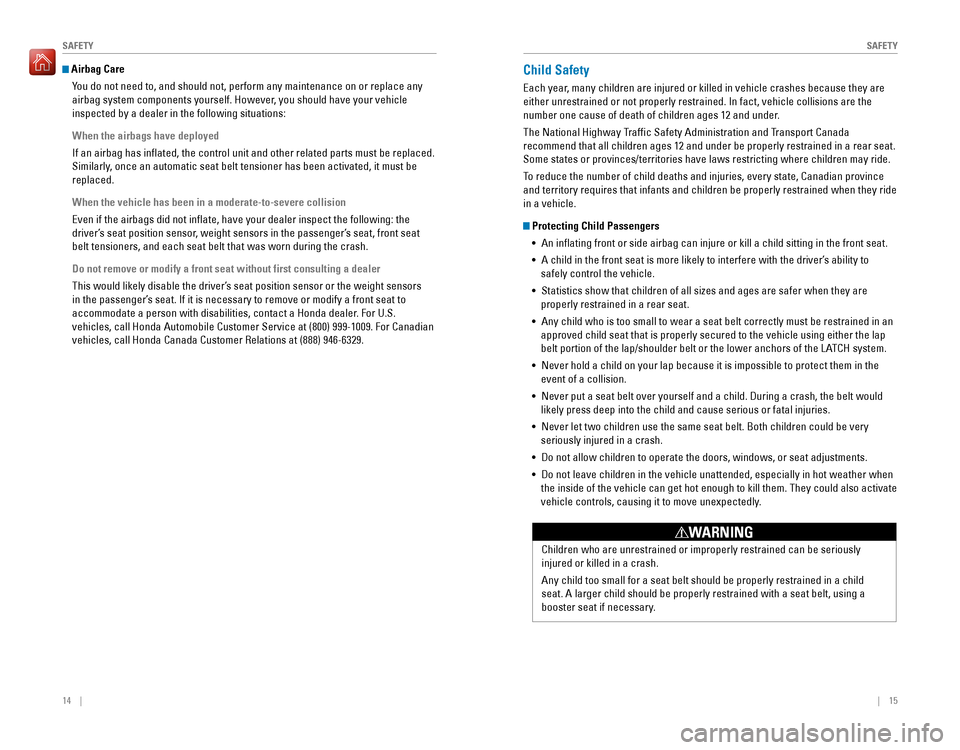
14 || 15
SAFETYSAFETY
Airbag Care
You do not need to, and should not, perform any maintenance on or replace\
any
airbag system components yourself. However, you should have your vehicle
inspected by a dealer in the following situations:
When the airbags have deployed
If an airbag has inflated, the control unit and other related parts mu\
st be replaced.
Similarly, once an automatic seat belt tensioner has been activated, it must be
replaced.
When the vehicle has been in a moderate-to-severe collision
Even if the airbags did not inflate, have your dealer inspect the foll\
owing: the
driver’s seat position sensor, weight sensors in the passenger’s seat, front seat
belt tensioners, and each seat belt that was worn during the crash.
Do not remove or modify a front seat without first consulting a dealer
This would likely disable the driver’s seat position sensor or the weight sensors
in the passenger’s seat. If it is necessary to remove or modify a front seat to
accommodate a person with disabilities, contact a Honda dealer. For U.S.
vehicles, call Honda Automobile Customer Service at (800) 999-1009. Fo\
r Canadian
vehicles, call Honda Canada Customer Relations at (888) 946-6329.Child Safety
Each year, many children are injured or killed in vehicle crashes because they are
either unrestrained or not properly restrained. In fact, vehicle collisi\
ons are the
number one cause of death of children ages 12 and under.
The National Highway Traffic Safety Administration and Transport Canada
recommend that all children ages 12 and under be properly restrained in \
a rear seat.
Some states or provinces/territories have laws restricting where childre\
n may ride.
To reduce the number of child deaths and injuries, every state, Canadian \
province
and territory requires that infants and children be properly restrained \
when they ride
in a vehicle.
Protecting Child Passengers• An inflating front or side airbag can injure or kill a child sitting i\
n the front seat.
• A child in the front seat is more likely to interfere with the driver’\
s ability to
safely control the vehicle.
• Statistics show that children of all sizes and ages are safer when they \
are
properly restrained in a rear seat.
• Any child who is too small to wear a seat belt correctly must be restrai\
ned in an
approved child seat that is properly secured to the vehicle using either\
the lap
belt portion of the lap/shoulder belt or the lower anchors of the LATCH system.
• Never hold a child on your lap because it is impossible to protect them \
in the
event of a collision.
• Never put a seat belt over yourself and a child. During a crash, the bel\
t would
likely press deep into the child and cause serious or fatal injuries.
• Never let two children use the same seat belt. Both children could be ve\
ry
seriously injured in a crash.
• Do not allow children to operate the doors, windows, or seat adjustments\
.
• Do not leave children in the vehicle unattended, especially in hot weath\
er when
the inside of the vehicle can get hot enough to kill them. They could al\
so activate
vehicle controls, causing it to move unexpectedly.
Children who are unrestrained or improperly restrained can be seriously \
injured or killed in a crash.
Any child too small for a seat belt should be properly restrained in a c\
hild
seat. A larger child should be properly restrained with a seat belt, usi\
ng a
booster seat if necessary.
WARNING
Page 12 of 89
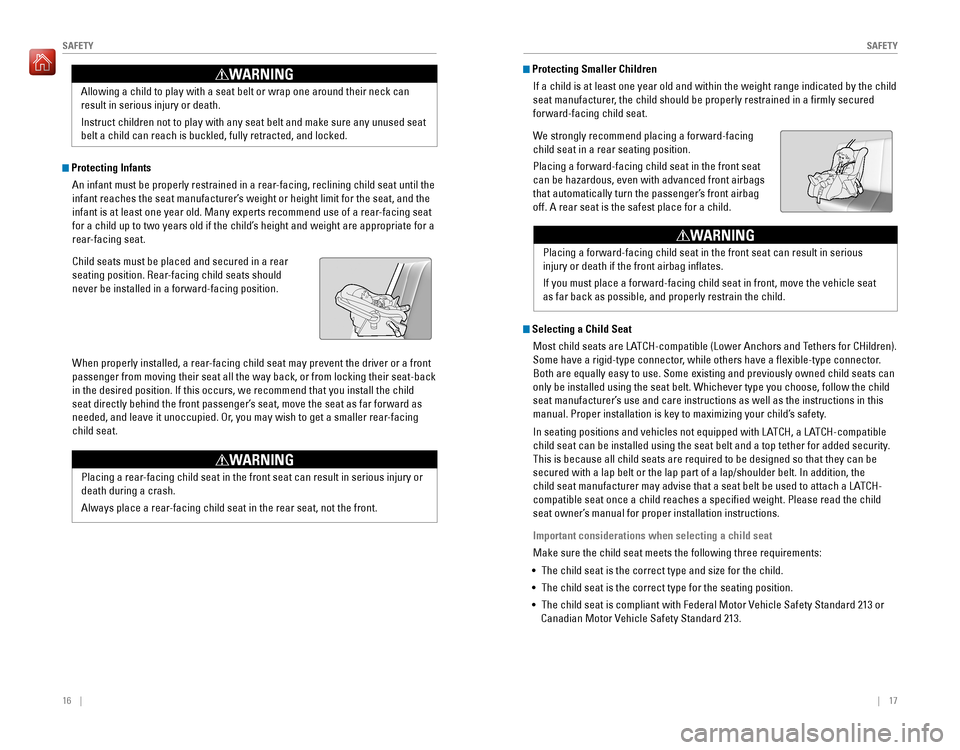
16 || 17
SAFETYSAFETY
Protecting Infants
An infant must be properly restrained in a rear-facing, reclining child seat until the
infant reaches the seat manufacturer’s weight or height limit for the seat, and the
infant is at least one year old. Many experts recommend use of a rear-facing seat
for a child up to two years old if the child’s height and weight are appropriate for a
rear-facing seat.
Child seats must be placed and secured in a rear
seating position. Rear-facing child seats should
never be installed in a forward-facing position.
When properly installed, a rear-facing child seat may prevent the driver or a front
passenger from moving their seat all the way back, or from locking their\
seat-back
in the desired position. If this occurs, we recommend that you install t\
he child
seat directly behind the front passenger’s seat, move the seat as far forward as
needed, and leave it unoccupied. Or, you may wish to get a smaller rear-facing
child seat.
Placing a rear-facing child seat in the front seat can result in serious injury or
death during a crash.
Always place a rear-facing child seat in the rear seat, not the front.
WARNING
Allowing a child to play with a seat belt or wrap one around their neck \
can
result in serious injury or death.
Instruct children not to play with any seat belt and make sure any unuse\
d seat
belt a child can reach is buckled, fully retracted, and locked.
WARNING Protecting Smaller ChildrenIf a child is at least one year old and within the weight range indicate\
d by the child
seat manufacturer, the child should be properly restrained in a firmly secured
forward-facing child seat.
We strongly recommend placing a forward-facing
child seat in a rear seating position.
Placing a forward-facing child seat in the front seat
can be hazardous, even with advanced front airbags
that automatically turn the passenger’s front airbag
off. A rear seat is the safest place for a child.
Placing a forward-facing child seat in the front seat can result in seri\
ous
injury or death if the front airbag inflates.
If you must place a forward-facing child seat in front, move the vehicle\
seat
as far back as possible, and properly restrain the child.
WARNING
Selecting a Child SeatMost child seats are LATCH-compatible (Lower Anchors and Tethers for CHildren).
Some have a rigid-type connector, while others have a flexible-type connector.
Both are equally easy to use. Some existing and previously owned child s\
eats can
only be installed using the seat belt. Whichever type you choose, follow\
the child
seat manufacturer’s use and care instructions as well as the instructions in this
manual. Proper installation is key to maximizing your child’s safety.
In seating positions and vehicles not equipped with LATCH, a LATCH-compatible
child seat can be installed using the seat belt and a top tether for add\
ed security.
This is because all child seats are required to be designed so that they\
can be
secured with a lap belt or the lap part of a lap/shoulder belt. In addit\
ion, the
child seat manufacturer may advise that a seat belt be used to attach a \
LATCH-
compatible seat once a child reaches a specified weight. Please read t\
he child
seat owner’s manual for proper installation instructions.
Important considerations when selecting a child seat
Make sure the child seat meets the following three requirements:
• The child seat is the correct type and size for the child.
• The child seat is the correct type for the seating position.
• The child seat is compliant with Federal Motor Vehicle Safety Standard 213 or
Canadian Motor Vehicle Safety Standard 213.
Page 13 of 89
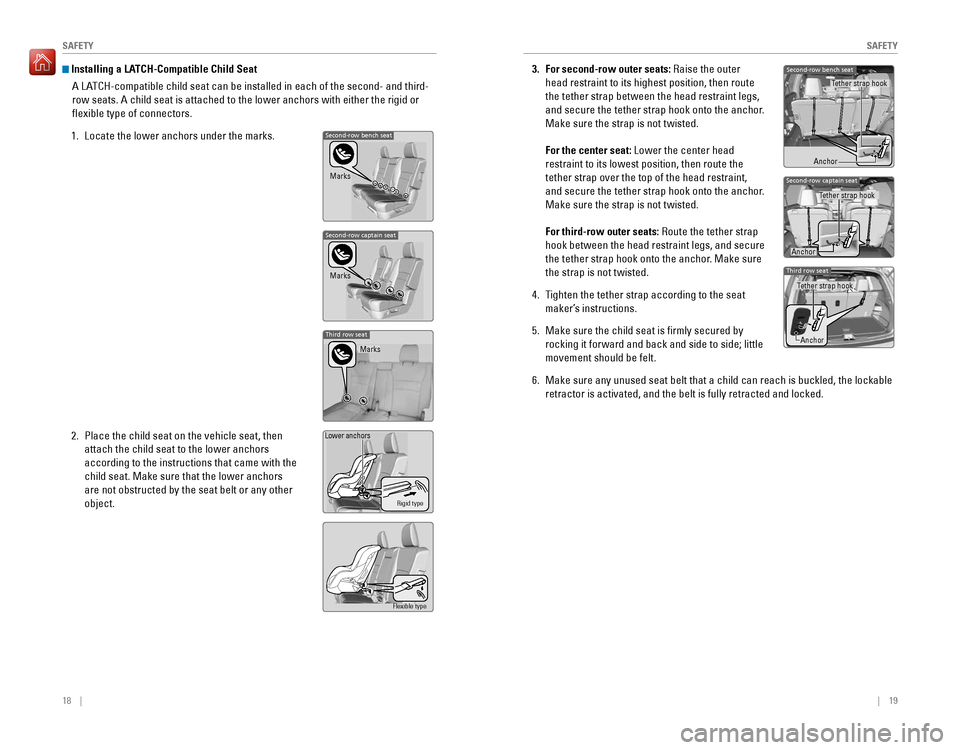
18 || 19
SAFETYSAFETY
Installing a LATCH-Compatible Child Seat
A LATCH-compatible child seat can be installed in each of the second- and th\
ird-
row seats. A child seat is attached to the lower anchors with either the\
rigid or
flexible type of connectors.
1. Locate the lower anchors under the marks.
2. Place the child seat on the vehicle seat, then
attach the child seat to the lower anchors
according to the instructions that came with the
child seat. Make sure that the lower anchors
are not obstructed by the seat belt or any other
object.
Second-row captain seat
Marks
Third row seat
Marks
3. For second-row outer seats: Raise the outer
head restraint to its highest position, then route
the tether strap between the head restraint legs,
and secure the tether strap hook onto the anchor.
Make sure the strap is not twisted.
For the center seat: Lower the center head
restraint to its lowest position, then route the
tether strap over the top of the head restraint,
and secure the tether strap hook onto the anchor.
Make sure the strap is not twisted.
For third-row outer seats: Route the tether strap
hook between the head restraint legs, and secure
the tether strap hook onto the anchor. Make sure
the strap is not twisted.
4. Tighten the tether strap according to the seat
maker’s instructions.
5. Make sure the child seat is firmly secured by
rocking it forward and back and side to side; little
movement should be felt.
6. Make sure any unused seat belt that a child can reach is buckled, the lo\
ckable
retractor is activated, and the belt is fully retracted and locked.
Second-row bench seat
Anchor
Tether strap hook
Second-row bench seat
Marks
Rigid type
Lower anchors
Flexible type
Second-row captain seat
Anchor
Tether strap hook
Third row seat
Anchor
Tether strap hook
Page 14 of 89
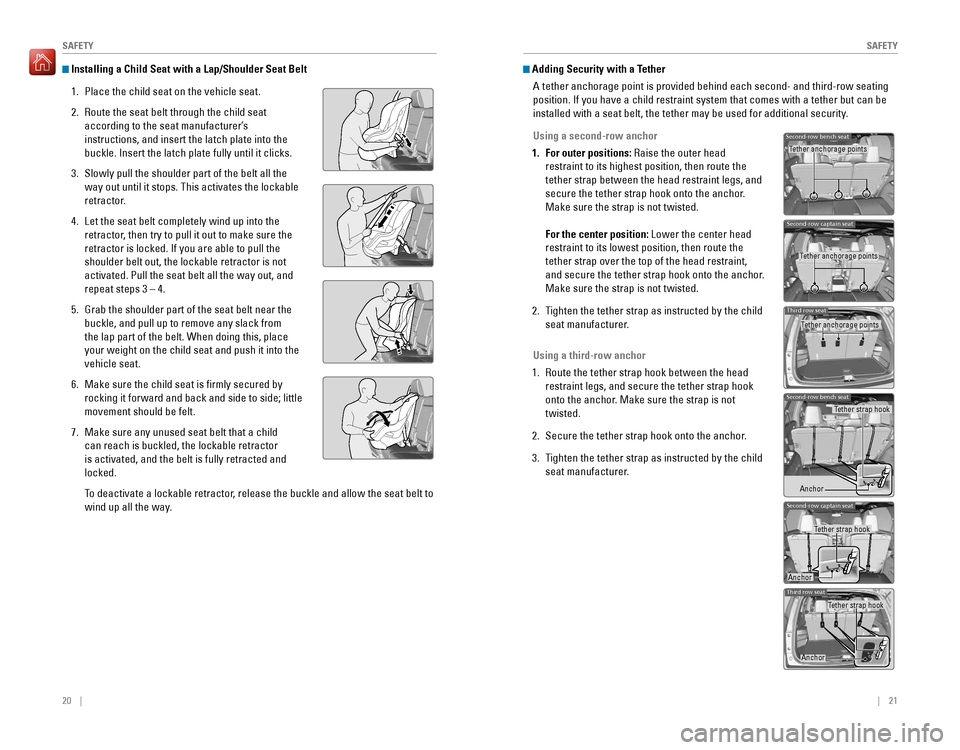
20 || 21
SAFETYSAFETY
Installing a Child Seat with a Lap/Shoulder Seat Belt
1. Place the child seat on the vehicle seat.
2. Route the seat belt through the child seat
according to the seat manufacturer’s
instructions, and insert the latch plate into the
buckle. Insert the latch plate fully until it clicks.
3. Slowly pull the shoulder part of the belt all the
way out until it stops. This activates the lockable
retractor.
4. Let the seat belt completely wind up into the
retractor, then try to pull it out to make sure the
retractor is locked. If you are able to pull the
shoulder belt out, the lockable retractor is not
activated. Pull the seat belt all the way out, and
repeat steps 3 – 4.
5. Grab the shoulder part of the seat belt near the
buckle, and pull up to remove any slack from
the lap part of the belt. When doing this, place
your weight on the child seat and push it into the
vehicle seat.
6. Make sure the child seat is firmly secured by
rocking it forward and back and side to side; little
movement should be felt.
7. Make sure any unused seat belt that a child
can reach is buckled, the lockable retractor
is activated, and the belt is fully retracted and
locked.
To deactivate a lockable retractor, release the buckle and allow the seat belt to
wind up all the way.
Adding Security with a Tether
A tether anchorage point is provided behind each second- and third-row s\
eating
position. If you have a child restraint system that comes with a tether \
but can be
installed with a seat belt, the tether may be used for additional securi\
ty.
Using a second-row anchor
1. For outer positions: Raise the outer head
restraint to its highest position, then route the
tether strap between the head restraint legs, and
secure the tether strap hook onto the anchor.
Make sure the strap is not twisted.
For the center position: Lower the center head
restraint to its lowest position, then route the
tether strap over the top of the head restraint,
and secure the tether strap hook onto the anchor.
Make sure the strap is not twisted.
2. Tighten the tether strap as instructed by the child
seat manufacturer.
Using a third-row anchor
1. Route the tether strap hook between the head
restraint legs, and secure the tether strap hook
onto the anchor. Make sure the strap is not
twisted.
2. Secure the tether strap hook onto the anchor.
3. Tighten the tether strap as instructed by the child
seat manufacturer.
Second-row bench seat
Tether anchorage points
Second-row captain seat
Tether anchorage points
Second-row bench seat
Tether strap hook
Anchor
Third row seat
Tether anchorage points
Second-row captain seat
Anchor
Tether strap hook
Third row seat
Anchor
Tether strap hook
Page 15 of 89
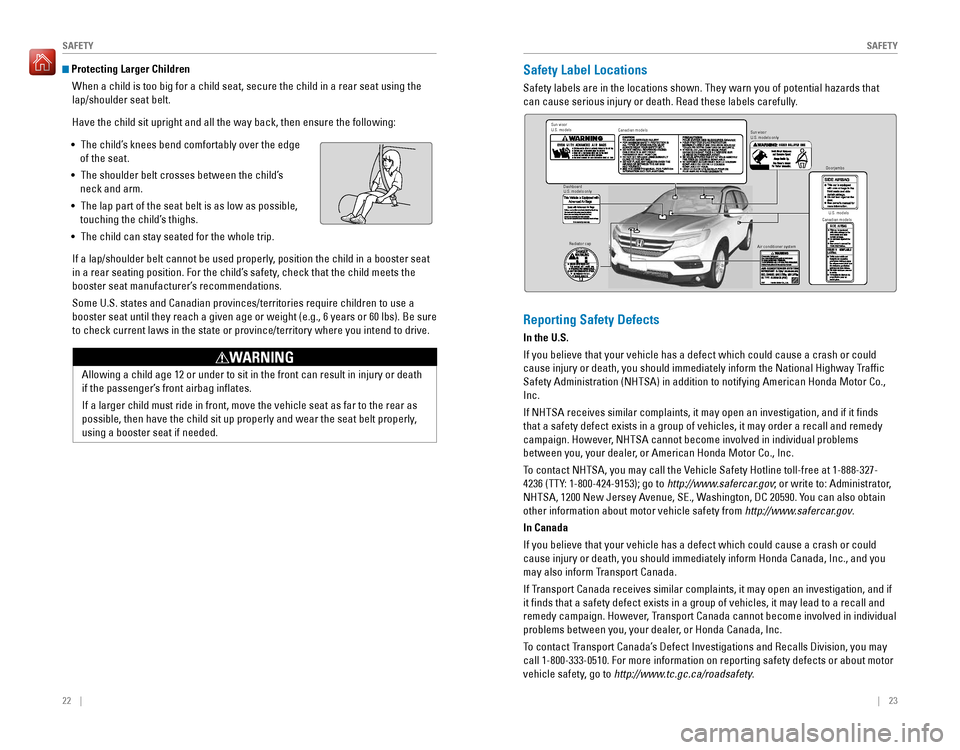
22 || 23
SAFETYSAFETY
Protecting Larger Children
When a child is too big for a child seat, secure the child in a rear sea\
t using the
lap/shoulder seat belt.
Have the child sit upright and all the way back, then ensure the followi\
ng:
• The child’s knees bend comfortably over the edge
of the seat.
• The shoulder belt crosses between the child’s
neck and arm.
• The lap part of the seat belt is as low as possible,
touching the child’s thighs.
• The child can stay seated for the whole trip.
If a lap/shoulder belt cannot be used properly, position the child in a booster seat
in a rear seating position. For the child’s safety, check that the child meets the
booster seat manufacturer’s recommendations.
Some U.S. states and Canadian provinces/territories require children to \
use a
booster seat until they reach a given age or weight (e.g., 6 years or 6\
0 lbs). Be sure
to check current laws in the state or province/territory where you inten\
d to drive.
Allowing a child age 12 or under to sit in the front can result in injur\
y or death
if the passenger’s front airbag inflates.
If a larger child must ride in front, move the vehicle seat as far to th\
e rear as
possible, then have the child sit up properly and wear the seat belt pro\
perly,
using a booster seat if needed.
WARNING
Safety Label Locations
Safety labels are in the locations shown. They warn you of potential haz\
ards that
can cause serious injury or death. Read these labels carefully.
Sun visor
U.S. models Canadian models
Radiator cap U.S. models
U.S. models only
Dashboard
Canadian modelsDoorjambs
Air conditioner syste mSun visor
U.S. models only
Reporting Safety Defects
In the U.S.
If you believe that your vehicle has a defect which could cause a crash \
or could
cause injury or death, you should immediately inform the National Highway Traffic
Safety Administration (NHTSA) in addition to notifying American Honda \
Motor Co.,
Inc.
If NHTSA receives similar complaints, it may open an investigation, and \
if it finds
that a safety defect exists in a group of vehicles, it may order a recal\
l and remedy
campaign. However, NHTSA cannot become involved in individual problems
between you, your dealer, or American Honda Motor Co., Inc.
To contact NHTSA, you may call the Vehicle Safety Hotline toll-free at 1-888-327-
4236 (TTY: 1-800-424-9153); go to http://www.safercar.gov; or write to: Administrator,
NHTSA, 1200 New Jersey Avenue, SE., Washington, DC 20590. You can also obtain
other information about motor vehicle safety from http://www.safercar.gov.
In Canada
If you believe that your vehicle has a defect which could cause a crash \
or could
cause injury or death, you should immediately inform Honda Canada, Inc.,\
and you
may also inform Transport Canada.
If Transport Canada receives similar complaints, it may open an investigation, and if
it finds that a safety defect exists in a group of vehicles, it may le\
ad to a recall and
remedy campaign. However, Transport Canada cannot become involved in individual
problems between you, your dealer, or Honda Canada, Inc.
To contact Transport Canada’s Defect Investigations and Recalls Division, you may
call 1-800-333-0510. For more information on reporting safety defects or\
about motor
vehicle safety, go to http://www.tc.gc.ca/roadsafety.
Page 16 of 89
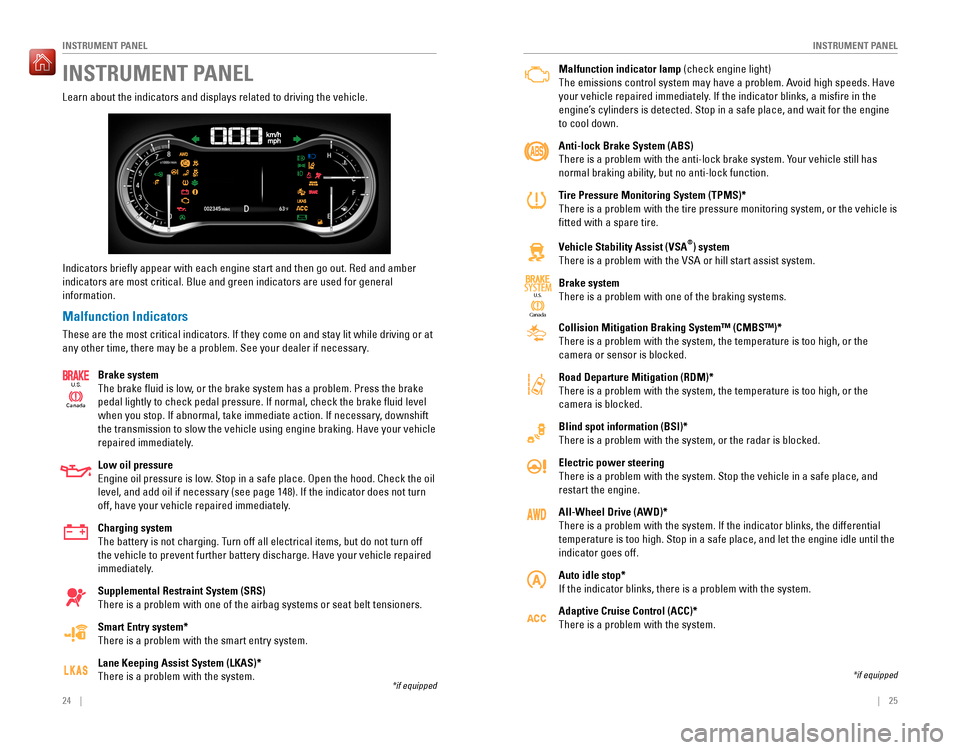
24 || 25
INSTRUMENT PANELINSTRUMENT PANEL
Learn about the indicators and displays related to driving the vehicle.
Indicators briefly appear with each engine start and then go out. Red \
and amber
indicators are most critical. Blue and green indicators are used for gen\
eral
information.
Malfunction Indicators
These are the most critical indicators. If they come on and stay lit whi\
le driving or at
any other time, there may be a problem. See your dealer if necessary.
Brake system
The brake fluid is low, or the brake system has a problem. Press the brake
pedal lightly to check pedal pressure. If normal, check the brake flui\
d level
when you stop. If abnormal, take immediate action. If necessary, downshift
the transmission to slow the vehicle using engine braking. Have your vehicle
repaired immediately.
Low oil pressure
Engine oil pressure is low. Stop in a safe place. Open the hood. Check the oil
level, and add oil if necessary (see page 148). If the indicator does \
not turn
off, have your vehicle repaired immediately.
Charging system
The battery is not charging. Turn off all electrical items, but do not turn off
the vehicle to prevent further battery discharge. Have your vehicle repa\
ired
immediately.
Supplemental Restraint System (SRS)
There is a problem with one of the airbag systems or seat belt tensioner\
s.
Smart Entry system*
There is a problem with the smart entry system.
Lane Keeping Assist System (LKAS)*
There is a problem with the system.
INSTRUMENT PANEL
Canada
U.S.
*if equipped
Malfunction indicator lamp (check engine light)
The emissions control system may have a problem. Avoid high speeds. Have
your vehicle repaired immediately. If the indicator blinks, a misfire in the
engine’s cylinders is detected. Stop in a safe place, and wait for the engine
to cool down.
Anti-lock Brake System (ABS)
There is a problem with the anti-lock brake system. Your vehicle still has
normal braking ability, but no anti-lock function.
Tire Pressure Monitoring System (TPMS)*
There is a problem with the tire pressure monitoring system, or the vehi\
cle is
fitted with a spare tire.
Vehicle Stability Assist (VSA
®) system
There is a problem with the VSA or hill start assist system.
Brake system
There is a problem with one of the braking systems.
Collision Mitigation Braking System™ (CMBS™)*
There is a problem with the system, the temperature is too high, or the \
camera or sensor is blocked.
Road Departure Mitigation (RDM)*
There is a problem with the system, the temperature is too high, or the \
camera is blocked.
Blind spot information (BSI)*
There is a problem with the system, or the radar is blocked.
Electric power steering
There is a problem with the system. Stop the vehicle in a safe place, an\
d
restart the engine.
All-Wheel Drive (AWD)*
There is a problem with the system. If the indicator blinks, the differe\
ntial
temperature is too high. Stop in a safe place, and let the engine idle u\
ntil the
indicator goes off.
Auto idle stop*
If the indicator blinks, there is a problem with the system.
Adaptive Cruise Control (ACC)*
There is a problem with the system.
Ca nada
U.S.SYSTEM
*if equipped
Page 17 of 89
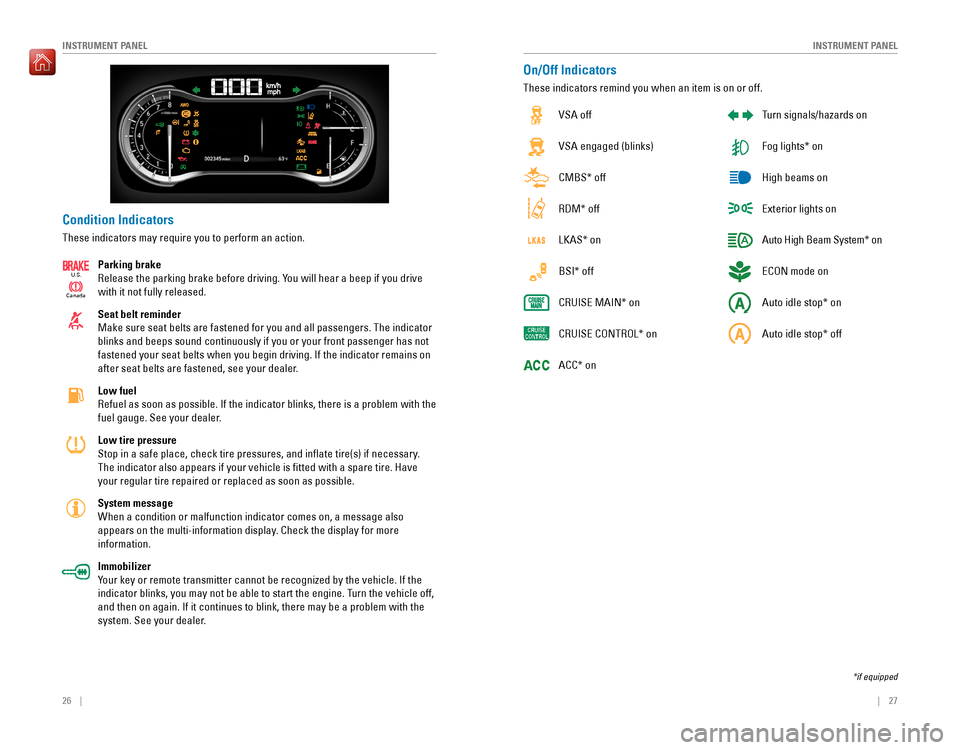
26 || 27
INSTRUMENT PANELINSTRUMENT PANEL
Condition Indicators
These indicators may require you to perform an action.
Parking brake
Release the parking brake before driving. You will hear a beep if you drive
with it not fully released.
Seat belt reminder
Make sure seat belts are fastened for you and all passengers. The indica\
tor
blinks and beeps sound continuously if you or your front passenger has not
fastened your seat belts when you begin driving. If the indicator remain\
s on
after seat belts are fastened, see your dealer.
Low fuel
Refuel as soon as possible. If the indicator blinks, there is a problem \
with the
fuel gauge. See your dealer.
Low tire pressure
Stop in a safe place, check tire pressures, and inflate tire(s) if n\
ecessary.
The indicator also appears if your vehicle is fitted with a spare tire\
. Have
your regular tire repaired or replaced as soon as possible.
System message
When a condition or malfunction indicator comes on, a message also
appears on the multi-information display. Check the display for more
information.
Immobilizer
Your key or remote transmitter cannot be recognized by the vehicle. If th\
e
indicator blinks, you may not be able to start the engine. Turn the vehicle off,
and then on again. If it continues to blink, there may be a problem with\
the
system. See your dealer.
Canada
U.S.
On/Off Indicators
These indicators remind you when an item is on or off.
VSA off
VSA engaged (blinks)
CMBS* off
RDM* off
LKAS* on
BSI* off
CRUISE MAIN* on
CRUISE CONTROL* on
ACC* on Turn signals/hazards on
Fog lights* on
High beams on
Exterior lights on
Auto High Beam System* on
ECON mode on
Auto idle stop* on
Auto idle stop* off
*if equipped
Page 18 of 89
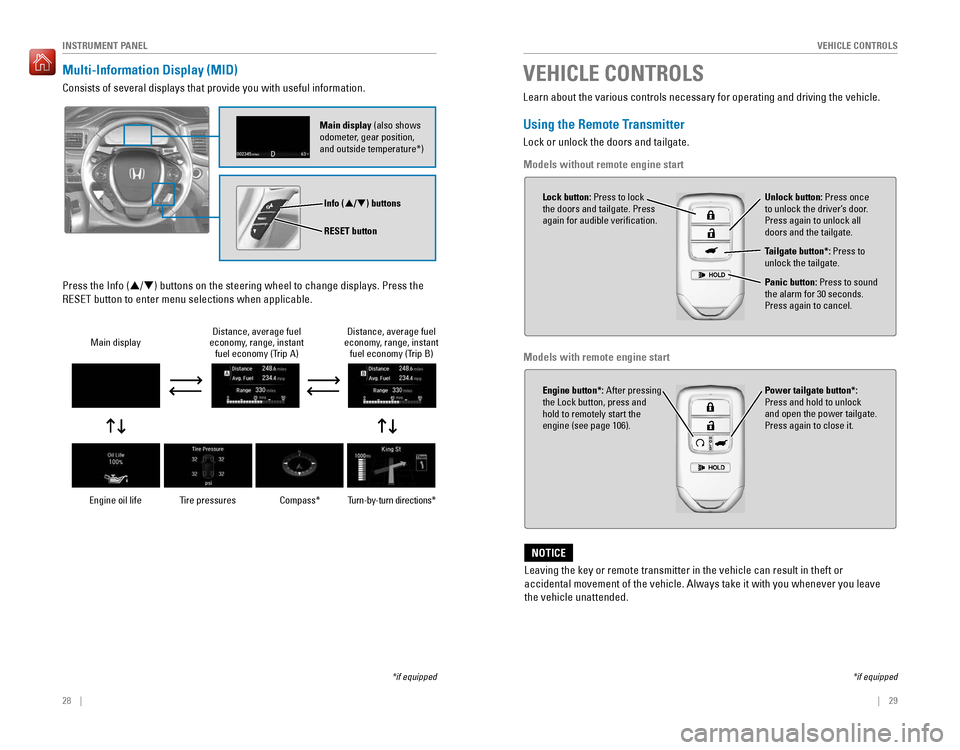
28 || 29
VEHICLE CONTROLSINSTRUMENT PANEL
Multi-Information Display (MID)
Consists of several displays that provide you with useful information.
Tire pressuresDistance, average fuel
economy, range, instant fuel economy (Trip A)
Main display
Compass*Distance, average fuel
economy, range, instant fuel economy (Trip B)
Turn-by-turn directions*
Press the Info (p/q) buttons on the steering wheel to change displays. Press the
RESET button to enter menu selections when applicable.
*if equipped
Info (p/q) buttons
RESET button
Engine oil life
Learn about the various controls necessary for operating and driving the\
vehicle.
Using the Remote Transmitter
Lock or unlock the doors and tailgate.
Models without remote engine start
Unlock button: Press once
to unlock the driver’s door.
Press again to unlock all
doors and the tailgate.
Power tailgate button*:
Press and hold to unlock
and open the power tailgate.
Press again to close it.
Lock button: Press to lock
the doors and tailgate. Press
again for audible verification.
Panic button: Press to sound
the alarm for 30 seconds.
Press again to cancel.
VEHICLE CONTROLS
*if equipped
Leaving the key or remote transmitter in the vehicle can result in theft\
or
accidental movement of the vehicle. Always take it with you whenever you\
leave
the vehicle unattended.
NOTICE
Tailgate button*: Press to
unlock the tailgate.
Engine button*: After pressing
the Lock button, press and
hold to remotely start the
engine (see page 106).
Main display (also shows
odometer, gear position,
and outside temperature*)
Models with remote engine start
Page 19 of 89
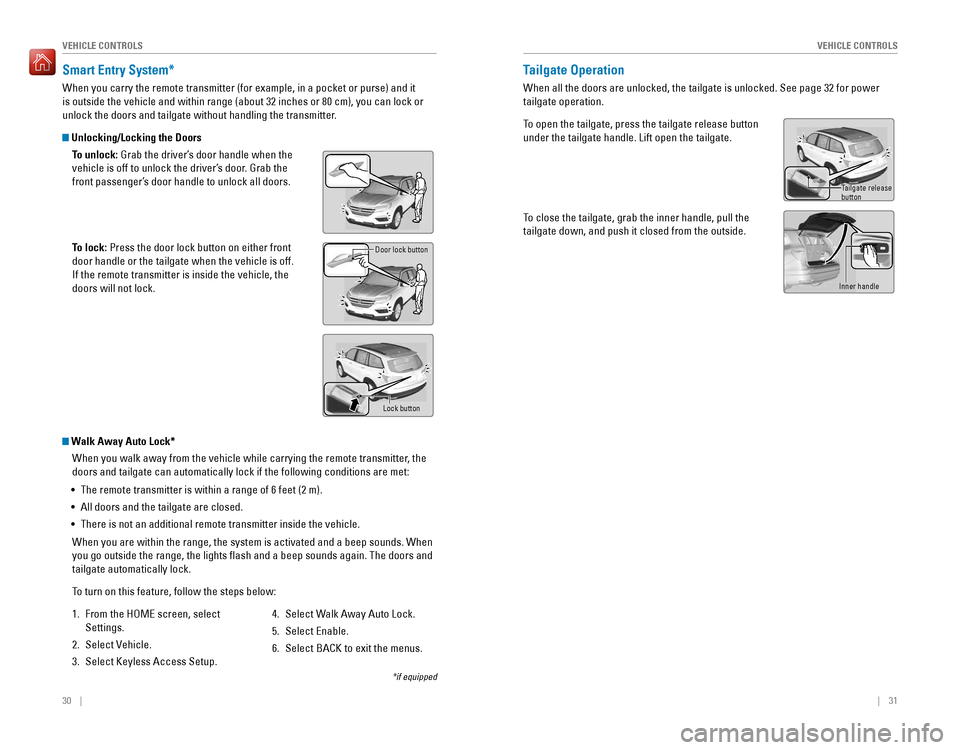
30 || 31
VEHICLE CONTROLSVEHICLE CONTROLS
Smart Entry System*
When you carry the remote transmitter (for example, in a pocket or purs\
e) and it
is outside the vehicle and within range (about 32 inches or 80 cm), yo\
u can lock or
unlock the doors and tailgate without handling the transmitter.
Unlocking/Locking the Doors
To unlock: Grab the driver’s door handle when the
vehicle is off to unlock the driver’s door. Grab the
front passenger’s door handle to unlock all doors.
To lock: Press the door lock button on either front
door handle or the tailgate when the vehicle is off.
If the remote transmitter is inside the vehicle, the
doors will not lock.
Door lock button
*if equipped
Walk Away Auto Lock*When you walk away from the vehicle while carrying the remote transmitter, the
doors and tailgate can automatically lock if the following conditions ar\
e met:
• The remote transmitter is within a range of 6 feet (2 m).
• All doors and the tailgate are closed.
• There is not an additional remote transmitter inside the vehicle.
When you are within the range, the system is activated and a beep sounds\
. When
you go outside the range, the lights flash and a beep sounds again. Th\
e doors and
tailgate automatically lock.
To turn on this feature, follow the steps below:
1. From the HOME screen, select
Settings.
2. Select Vehicle.
3. Select Keyless Access Setup.
4. Select Walk Away Auto Lock.
5. Select Enable.
6. Select BACK to exit the menus.
Lock button
Tailgate Operation
When all the doors are unlocked, the tailgate is unlocked. See page 32 f\
or power
tailgate operation.
To open the tailgate, press the tailgate release button
under the tailgate handle. Lift open the tailgate.
To close the tailgate, grab the inner handle, pull the
tailgate down, and push it closed from the outside.
Tailgate releasebutton
Inner handle
Page 20 of 89
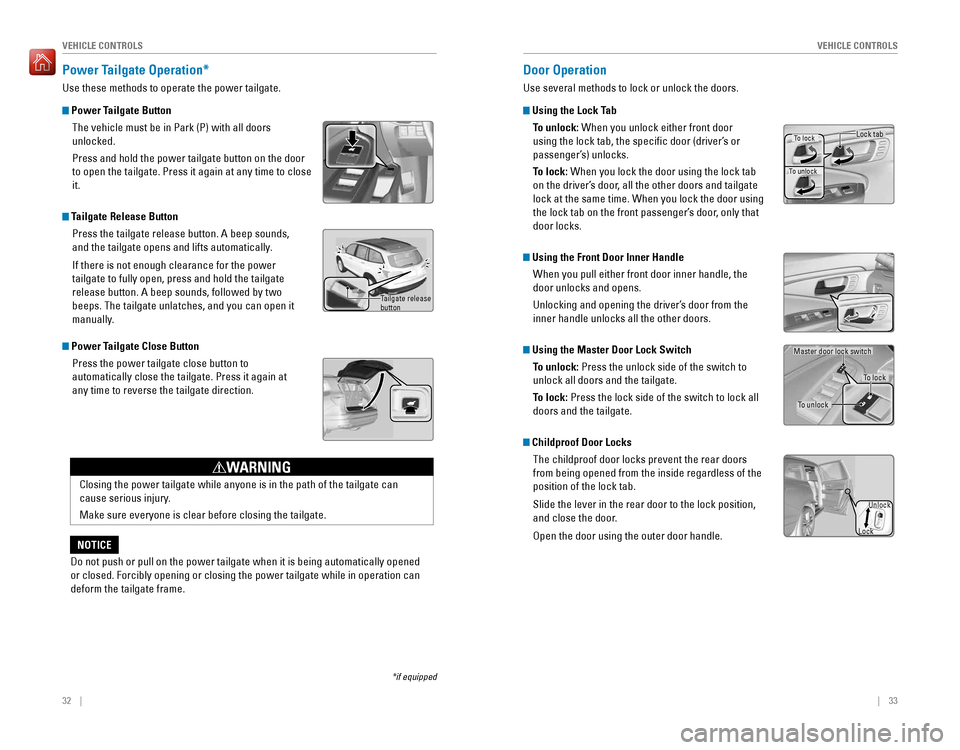
32 || 33
VEHICLE CONTROLSVEHICLE CONTROLS
Power Tailgate Operation*
Use these methods to operate the power tailgate.
Power Tailgate Button
The vehicle must be in Park (P) with all doors
unlocked.
Press and hold the power tailgate button on the door
to open the tailgate. Press it again at any time to close
it.
Tailgate Release ButtonPress the tailgate release button. A beep sounds,
and the tailgate opens and lifts automatically.
If there is not enough clearance for the power
tailgate to fully open, press and hold the tailgate
release button. A beep sounds, followed by two
beeps. The tailgate unlatches, and you can open it
manually.
Power Tailgate Close ButtonPress the power tailgate close button to
automatically close the tailgate. Press it again at
any time to reverse the tailgate direction.
Closing the power tailgate while anyone is in the path of the tailgate c\
an
cause serious injury.
Make sure everyone is clear before closing the tailgate.
WARNING
Do not push or pull on the power tailgate when it is being automatically\
opened
or closed. Forcibly opening or closing the power tailgate while in opera\
tion can
deform the tailgate frame.
NOTICE
*if equipped
Door Operation
Use several methods to lock or unlock the doors.
Using the Lock TabTo unlock: When you unlock either front door
using the lock tab, the specific door (driver’s or
passenger’s) unlocks.
To lock: When you lock the door using the lock tab
on the driver’s door, all the other doors and tailgate
lock at the same time. When you lock the door using
the lock tab on the front passenger’s door, only that
door locks.
Using the Front Door Inner HandleWhen you pull either front door inner handle, the
door unlocks and opens.
Unlocking and opening the driver’s door from the
inner handle unlocks all the other doors.
Using the Master Door Lock SwitchTo unlock: Press the unlock side of the switch to
unlock all doors and the tailgate.
To lock: Press the lock side of the switch to lock all
doors and the tailgate.
Childproof Door LocksThe childproof door locks prevent the rear doors
from being opened from the inside regardless of the
position of the lock tab.
Slide the lever in the rear door to the lock position,
and close the door.
Open the door using the outer door handle.
To lockLock tab
To lock
To unlock
Master door lock switch
LockUnlock
To unlock
Tailgate releasebutton